Bowers & Wilkins 802D Cherrywood B&W BW Bower very good condition
Listed · 1745 Views
4 Watchers
Items from this seller
This listing has ended.
Listings Similar to Bowers & Wilkins
Time Left: Listing Sold
This listing has ended.
| Condition | |
| Payment methods | |
Contact seller after sale to pay viaCertified check, Personal check, COD or Wire Transfer | |
| Ships from | Albuquerque, NM, 87110 |
| Ships to | United States |
| Package dimensions | unspecified |
| Shipping carrier | Local pickup only |
| Shipping cost | N/A |
| Research Pricing |
1 pair of B&W 802D in cherrywood finish, more than $650 below AudioGon average bluebook. These speakers sound spectacular with an incredible <1.0% THD from 40Hz - 100kHz. Detailed, huge soundstage, effortless, transparent, excellent bass extension, the amazing diamond tweeter, all of the qualities desired in a world-class loudspeaker. In very good condition, some sun fading only visible when the woofer grilles are removed, difficult to notice (see picture 1), some perforations and abrasions in the leather top, near the backs of the speakers, hard to photograph or notice (see pictures 11 and 12). Drive units are all like new, as is sound quality. This is a one-owner pair that I happen to know the history of since I installed them and have now picked them up. These were owned and carefully operated by an audiophile with Krell amplification. Also included is the excellent, B&W spike foot / soft foot kit and the much better sounding, metal midrange phase plugs. Cherrywood cabinets, drive units, grilles, binding posts are all in like-new condition. I do not have the factory boxes, but I'm willing to deliver and setup (at my asking price) within a 200 mile radius of Albuquerque, NM. Please see my decade plus, of 100% positive feedback. Glowing reviews can be found everywhere...below is one from Stereophile magazine.
Back in the 1970s, I used to hang out at an audio store on Northern Boulevard's Miracle Mile. After business hours—and sometimes during them—a group of us audiophiles would put every new product through the wringer. One of the most anticipated was the original B&W 801, which appeared in 1979. The 801 was simply unflappable. Fed enough power, a pair of them played louder and cleaner than anything we had ever heard, including the mammoth, multimodule Fultons that were the pride of that shop. But—and this was a big but—the 801 lacked immediacy and engagement, and I soon fell back to preferring an earlier B&W model, the DM6, which seemed more coherent and to offer the music out to the listener. The 801 was more objective and detached, but boy, could it knock you over with the right source material.
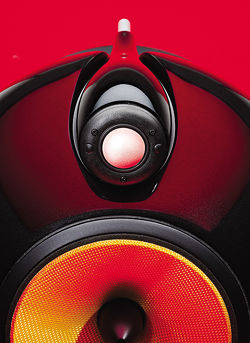 Perhaps I was imprinted by that experience. Afterward, I observed the introduction of each successive generation of the 800 series with interest but some detachment—until I reviewed the Signature 800 for the June 2002 Stereophile. No need for you to consult the archives—I was very impressed with the Signature 800, finding it much more outgoing and immediate-sounding than I'd expected, and with no faults other than a less-than-generous lateral soundstage and a tendency toward a more in-your-face sound than I ultimately preferred. But despite the Signature 800's all-around excellence, B&W now offers a new 800 series that retains many features of the earlier series—and some substantial changes.
Perhaps I was imprinted by that experience. Afterward, I observed the introduction of each successive generation of the 800 series with interest but some detachment—until I reviewed the Signature 800 for the June 2002 Stereophile. No need for you to consult the archives—I was very impressed with the Signature 800, finding it much more outgoing and immediate-sounding than I'd expected, and with no faults other than a less-than-generous lateral soundstage and a tendency toward a more in-your-face sound than I ultimately preferred. But despite the Signature 800's all-around excellence, B&W now offers a new 800 series that retains many features of the earlier series—and some substantial changes. Description
The innovations B&W has included in its new 800 series include tweeters with diamond domes, redesigned Kevlar FST midrange cones, new woofer diaphragm materials, and a new crossover configuration. And while to the casual observer the 802D may look much like its predecessor, the Nautilus 802, there are external changes as well.
The 1" tweeter used in the new 800 series has a dome of vacuum-deposited particles of diamond, which, though not as low in mass as materials such as beryllium, possesses greater stiffness in the useful frequency range. With its new suspension and motor assembly, the tweeter's lowered fundamental resonance also permits a first-order, 6dB/octave crossover to the midrange, which in turn dictated the new series' most obvious external feature: the bullet-shaped tweeter enclosure is now embedded deeper into the midrange enclosure, so that the tweeter and midrange drive-units are in phase at the crossover frequency.
The 6" Kevlar-cone midrange driver, in B&W's signature yellow tint, has been updated with the addition of a foam damping ring under the cone periphery, and its more powerful but smaller neodymium magnet structure and redesigned basket mean that obstruction of the cone's rear radiation is greatly reduced. The controversial FST midrange cone is still intended to break up in a controlled manner, but even more uniformly and predictably. Again, the characteristic midrange Nautilus-shell is nestled into the soft, glove-leather embrace of the main enclosure, as in earlier 800-series speakers.
Two 8" woofers with Rohacell diaphragms complete the driver array. Rohacell is a lightweight sandwich of rigid foam between sheets of carbon fiber. B&W engineers like to demonstrate its remarkable stiffness by standing on a speaker cone unsupported by frame or magnet assembly.
B&W's proprietary Matrix construction is retained for the woofer cabinet, but the 802D's base and port are inherited from the Signature 800. The flared port is lined with dimples that, like those on a golf ball, are intended to reduce air turbulence, providing for noiseless laminar flow at all sound-pressure levels. Further, the port is aimed downward at and precisely spaced from a fixed base. The construction, shape, and relationship of the base to the port fixes the port's performance and makes it independent of floor coverings and mounting devices, such as casters and spikes. The wider bandwidths of the new drive-units allowed B&W to simplify the crossover, with fewer passive elements in the signal path between input and driver.
Biamp terminals and jumpers are provided, as are machined aluminum phase plugs to replace the plastic ones, if you can live without protective screens over the Kevlar midrange drivers.
Setup
As before, B&W provided me with delivery and setup—these babies weigh 176 lbs each. Still, I was impressed by the clever design of the reusable packing and think that the average healthy buyer should be able to handle moving these speakers, with a little help from a friend. The little casters provided aid in positioning the speakers on carpets but might mar a hardwood floor.
Rolled into position in my main system, the 802Ds seemed only a bit less imposing than the Signature 800s and no less beautiful. After biwiring them with AudioQuest Mont Blanc/DBS to my bridged Bel Canto eVo6 monoblocks, I immediately noticed the 802D's relatively high sensitivity—my system's default settings were a bit generous for them. Even with the level controls trimmed, the 802D still displayed a little British reserve, but sounded good enough for the B&W guys to know that their work was done.
Of course, that was not enough for me. I spent the next few weeks fussing with exact speaker position, orientation, and room treatments to optimize the 802Ds' performance as perceived at my regular listening position. They ended up in almost the same places where they'd begun, but with a toe-in of about 10°. I moved a pair of Echo Buster Phase-4 traps into the room corners behind the speakers, rotated to expose their more reflective sides, and placed a pair of regular Echo Busters directly to the 802Ds.
Sound
The 802D, like other topnotch designs, was immediately musically appealing and disarming. The bass was full, the presentation somewhat forward. The 802D seemed to invigorate favorite old recordings, drawing me into the music. Though I must now proceed to the analytical, the 802D kept pulling me away from that responsibility.
Starting with the bass, the 802D did a great job. Extreme low bass, which depends as much on the room and speaker position as on the speaker itself, was extended, but less so than I recall hearing from the larger Signature 800, or than I can get from a dedicated subwoofer. That said, the quality of the low bass and midbass, where voices and overall tonal balance begin, was excellent. Cellos and basses, both orchestral and electric, had weight and impact but retained all their distinguishing overtones in appropriate balance. Listening through the 802Ds to the opening lower strings of Boccherini's La Musica Notturna delle Strade di Madrid, from the Stuttgart Chamber Orchestra's Die Röhre—The Tube (SACD, Tacet SACD74), was scarily close to getting the Stuttgarters themselves into my chamber. Nor was there any need to suspend disbelief when the higher strings entered with smooth strokes and delicate pizzicatos.
I then pulled out my old bass torture discs. The 802D was capable of pounding power without losing the characteristic acoustic qualities of the electronic Cosmic Hippo or of Saint-Saëns' Symphony 3. While some bass EQ to minimize room influence might have been useful, it was clear that my room and the 802D's low end nicely accommodated each other; short of sound effects, I had no need of a subwoofer.
Because the 802D splits the range of the human voice by crossing over from the woofers to the midrange driver at 350Hz, it was remarkable that I heard no discontinuities in voices that spanned that transition. Instead, they were full and somewhat forward, which suited some better than others. Lorraine Hunt Lieberson's mezzo-soprano on her Handel Arias (SACD/CD, Avie AV0030) had a smooth, engaging presence, but Patricia Barber sounded almost too intense on her Café Blue (SACD, Mobile Fidelity MFSA2002).
I also found that, just below the lower crossover frequency, the smoothness of lower male voices varied when I used different power amps. Men sounded full and forward with the sainted McCormack DNA-1 Rev.A, a bit less forward but still ripe with the Simaudio Moon W-8. With either amp, male voices and lower strings had a greater-than-natural heft that some visitors found impressive. With the Classé Omicrons or bridged Bel Canto eVo6s, that range was not emphasized though still full enough to be thoroughly engaging and realistic, but was disappointingly lean with the admittedly overmatched 56W of the Linn Chakra C4100 amp. I settled on the eVo and the Omicrons for most of my listening.
Regardless of the power amp used, the 802D exhibited degrees of detail resolution and clarity from the midrange up that could put some electrostatic speakers to shame. The speaker's generous bass helped it to engage me in a way that few speakers have, including B&W's own estimable Signature 800 or my reference, the Revel Ultima Studio. Perhaps this was due to the diamond tweeter's transparency without any glint or tizz. Cymbals, struck or brushed, had realistic initial transients and extended, detailed decays. There was no subjective brightness in the highs from any musical source, and the soft background hiss of FM broadcasts was extended, as with the other speakers. The 802D's upper-range transparency was as likely due to the seamless integration of its diamond tweeter with its midrange, both mounted in the unique Nautilus head unit, which blended their outputs into what seemed a single, indivisible sound source even when listened to from only a few inches away.
All of these probably contributed to the 802Ds' open, wide, deep soundstage, which seemed almost completely disassociated from the physical structures of the speakers themselves. Especially in the upper midrange and treble, voices and instruments were magically arrayed in a large three-dimensional space that began well in front of the speakers. The 802Ds did equally impressive jobs with small jazz ensembles such as Ray Brown's, on his Soular Energy (DVD-Audio, Concord Jazz DVD2011), and small chamber groups such as Pavel Serbin's Pratum Integrum Orchestra on The Italian Album, a disc of music by Dmitry Bortnyansky (SACD/CD, Caro Mitis CM 0042003), revealing all the intricacies and interactions while simultaneously establishing their presence in the ambience of an actual performance space. In fact, so generous was the 802Ds' spatial rendition that switching to the multichannel tracks of the Bortnyansky hybrid SACD gave only a subtle increase in soundstage width and virtually no change in balance, resolution, or soundstage depth.
I then hauled out the big stuff. I went happily from Verdi's Requiem, with Nikolaus Harnoncourt and the Vienna Philharmonic (SACD, RCA 61244-2), to Mahler's Symphony 5, with Yuri Temirkanov and the St. Petersburg Philharmonic (SACD, Water Lily Acoustic WLA-WS-76-SACD), to excerpts from Pink Floyd's The Wall, from Burmester's test CD Vorführungs CD II—nothing fazed the 802Ds. Given sufficient amplifier power—and I'm sure they could have handled more than I had on hand—the speakers played very loud without any change in character or balance. All I had to do was find the musically appropriate levels and these babies delivered. In that way, they recalled the original, unflappable B&W 801s.However, the 802D was infinitely more winning and appealing as a presenter of music. Sure, the Verdi Requiem's Dies Irae is powerful—but at the same volume setting, there was delicacy and immediacy in the Ingemisco and Libera me. The St. Petersburg's Mahler 5, so detailed and coherent through my multichannel system, was tightly focused and weighty through the two 802Ds, as if I were looking down on a massive, intricate engine. And from the hair-raising helicopter to the careening voiceovers and spine-tingling children's voices, the Pink Floyd excerpts pounded the room as if the walls had come alive with throbbing pulses. Any limits here were due solely to my own and my neighbors' tolerance.
Tough Choices
The B&W 802D demanded the right amplifier to ensure that its upper bass wouldn't be excessive. Some may like such ripeness, but it can become increasingly distracting with extended listening. Any partnering amp must provide gobs of power and a slightly lean and tight upper-bass range of its own. The bridged Bel Canto eVo6s—especially when run from the APC S-15 and Environmental Potentials EP-2450 power conditioners—and the Classé Omicrons fit the bill. I was surprised to find that, despite the 802D's high sensitivity, it was still pretty power-hungry. It will make decent sounds with a small amp, but might sound as if it's being starved.
Another issue some will have with the 802D is with a feature that I found very attractive. Unlike many more timid speakers that are characterized by a slight midrange dip (such as the original Kharma Ceramique 2), the 802Ds projected the music and the soundstage out in front of them. This made listening to them sound like listening in the nearfield even when I sat, as I do, about 12' back. I found this exciting, involving, and addicting, and though I expected it to become fatiguing, over the span of months that has not happened. Nonetheless, the difference in image presentation between the 802Ds and my Revel Ultima Studios, whose frequency response John Atkinson measured as quite flat, was readily apparent.
Recordings of solo piano are superb for distinguishing different speakers' defining characteristics of presence and timbre. First, the piano is capable of wide ranges of frequency and dynamics. Second, it is a large instrument that produces different sounds from its different sections. Third, its sound includes both percussive and woodily resonant components. I chose for my A/B test a recording of Earl Wild performing four Ballades and four Scherzos of Chopin (CD, Chesky CD44).
Wild's Baldwin piano sounded excitingly big and up-front through the 802Ds. There was tons of detail, high and low, and I could easily discern the changing resonances of the piano's body as Wild held, then released the sustain pedal. It was as if the piano was situated directly between the 802Ds, with Wild at the keyboard to the left. However, I thought I could also discern treble and bass notes as sounding somewhat separate from each other in space, and from the resonances radiating from the cabinet.
When I switched back to the Revel Ultima Studios, I needed some time to adapt before I could again appreciate my reference speakers. Even after I'd compensated for the B&W's higher sensitivity, the piano was immediately more tightly defined in space and farther away, and its details and intricacies were much less apparent. The Revels' highs often stood out brightly on the ping of treble notes. Nonetheless, I felt that the Revels integrated all of the piano's various parts into one coherent instrument, as well as revealing more of the performance space. The 802Ds were much more revealing of the piano itself, and threw it in greater relief against the backdrop of the recorded ambience. I can easily appreciate how mastering and balance engineers might find the B&W 802D a magnificent tool for hearing into a mix.
Lest you've failed to notice, the 802D is large. You can get good, clean sound at reasonably high volumes from much smaller boxes, such as NHT's Xd system, which I reviewed in the November 2005 Stereophile. However, there's something about big boxes that helps them sound harmonically balanced at all dynamic levels. Small boxes, with or without subwoofers and/or sophisticated EQ, can do wonderful things and, not insignificantly, are aided by their visual unobtrusiveness. Speakers such as the B&W 802Ds and my Revel Ultima Studios—to say nothing of such monsters as the Wilson Audio MAXX2s—fill the room in unique and different ways, challenging you to ignore their bulk—to close your eyes, if necessary. Technology may have an impact on that distinction, but, so far, if you want the level of performance I've described, you have to make room for the B&W 802D.
Conclusions
The B&W 802D came to play. It brings the musical performance into the room, right in front of the listener, rather than opening a window on a performance happening in some other, more distant space. Such powerful immediacy without glare or stridency is thrilling and untiring.
Like B&W's Signature 800, the 802D represents the cutting edge of modern speaker technology in terms of driver design, cabinet construction, and laboratory analysis, in addition to its exquisite fit and finish. The result, due in no small part to the extraordinary smoothness of the new diamond tweeter and its integration with the other drive-units, is a speaker that is remarkably transparent and detailed throughout the audible range. Given a couple of hundred clean watts behind it, the 802D has no significant performance limits in terms of dynamics or resolution.
I try to restrict the speakers I review to those that interest me and that I can afford, and sometimes I question whether I should replace my current references. The 802D is pretty much at the outer limit of what I can afford, but it has forced just such a consideration.
Sidebar 1: SpecificationsDescription: Three-way, floorstanding, reflex-loaded loudspeaker. Drive-units: 1" diamond-dome tweeter, 6" Kevlar FST-cone midrange unit, two 8" Rohacell-cone woofers. Crossover frequencies: 350Hz, 4kHz. Frequency response: 34Hz–28kHz, ±3dB, on axis (–6dB at 27Hz and 33kHz). Dispersion within 2dB of reference response: ±60° horizontal, ±10° vertical. Impedance: 8 ohms nominal, 3.5 ohms minimum. Sensitivity: 90dB/2.83V/m. Harmonic distortion (second and third harmonics, 90dB/m): <1% (40Hz–100kHz), <0.5% (70Hz–100kHz). Recommended amplification: 50–500W.
Dimensions: 44.7" (1138mm) H by 14.5" (363mm) W by 22.2" (565mm) D. Weight, each: 176 lbs (80kg) net, 196 lbs (89kg) shipping.
Finish: Cherrywood-veneer with leather accents, woofer enclosure, lacquered Marlan (synthetic mineral-filled resin) mid and HF enclosures.
Serial numbers of units reviewed: 557, 558.
Price: $14,000/pair. Approximate number of dealers: 250.
Manufacturer: B&W Loudspeakers, Dale Road, Worthing, West Sussex BN11 2BH, England, UK. US: B&W Group North America, 54 North Concord Street, North Reading, MA 01864-2699. Tel: (978) 664-2870. Fax: (978) 664-4109. Web: http://www.bowers-wilkins.com/
I estimated the B&W 802D's voltage sensitivity as 89dB(B)/2.83V/m, within experimental error of the specified 90dB figure and usefully higher than the average of the more than 500 speakers I have measured in the past 16 years. The B&W's impedance plot (fig.1) reveals the speaker to be moderately difficult to drive, with a magnitude that drops to 3 ohms throughout the upper bass and an awkward combination of 4 ohms and –50° electrical phase angle at 60Hz. In addition, the very high peak between 2 and 3kHz, resulting from the tweeter/midrange crossover, will give a somewhat forward tonal balance with amplifiers having a significant source impedance; say, tube models.
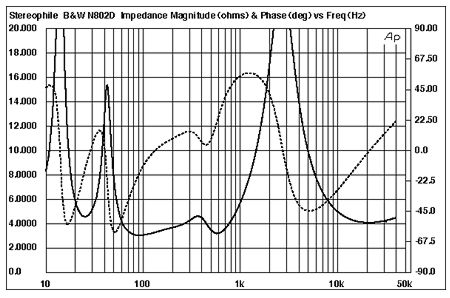
Fig.1 B&W 802D, electrical impedance (solid) and phase (dashed). (2 ohms/vertical div.)
B&W's use of its Matrix construction technique in the 802D's woofer enclosure makes the speaker acoustically inert. Fig.2, for example, shows a cumulative spectral-decay plot calculated from the output of an accelerometer fastened to the sidewall 12" from the top. Just one mode can be seen above the –30dB floor of this graph, at the frequency of the upper impedance peak in the bass, but this is still so far down in level as to be insignificant. I performed a similar analysis of the midrange enclosure's vibrational behavior, but I haven't shown it because it indicates nothing going on above the graph's floor. Nothing. De nada. Rien. This speaker has one inert cabinet (or two).

Fig.2 B&W 802D, cumulative spectral-decay plot calculated from the output of an accelerometer fastened to the center of the cabinet's side panel 12" from base (MLS driving voltage to speaker, 7.55V; measurement bandwidth, 2kHz).
The saddle centered at 26Hz in the impedance-magnitude trace (fig.1) suggests a very low tuning frequency for the downward-firing port. This is confirmed by the port's frequency response, measured in the nearfield (fig.3, blue trace). This covers quite a wide bandpass, centered on the woofers' minimum-motion frequency of 26Hz (red trace), with a couple of low-level peaks evident in the midrange. The woofers cross over to the midrange unit (green) just above 300Hz, with what appear to be asymmetrical slopes: second-order low-pass to the woofers, and third-order high-pass to the midrange. (All these traces are plotted in the ratio of the root of the radiating areas.) The overall sum of these individual low-frequency responses, taking acoustic phase into account, is the black trace in fig.3. While there appears to be a touch of boost in the upper bass, some of this will be due to the nearfield measurement technique. The B&W is pretty much maximally flat to 30Hz, which is impressive bass extension.
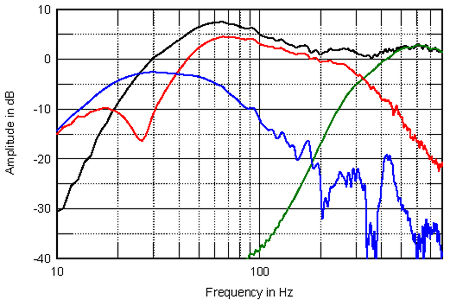
Fig.3 B&W 802D, nearfield responses of midrange unit (green), woofer (red), and port (blue), with the complex sum of the nearfield woofer and port responses, taking into account acoustic phase and distance from the nominal farfield point (black).
This low-frequency curve is repeated on the left side of fig.4, which otherwise shows the 802D's farfield response averaged across a ±15° horizontal window on the tweeter axis. Again, some of the upper-bass boost will be due to the measurement technique, but I note that Kal Rubinson did find the speaker's low frequencies to be balanced on the ripe side of neutrality, which is what I would have expected from this graph. Moving higher in frequency, the 802D's mid-treble is slightly uneven, but the response is otherwise very flat, particularly in the midrange. The diamond-dome tweeter is also giving out pretty much full level to the 30kHz limit of this graph, which is where my measurement microphone's calibration ends.
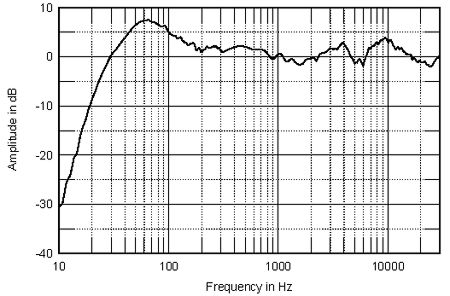
Fig.4 B&W 802D, anechoic response on tweeter axis at 50", averaged across 30° horizontal window and corrected for microphone response, with the complex sum of the nearfield midrange, woofer, and port responses, taking into account acoustic phase and distance from the nominal farfield point, plotted below 300Hz.
As can be seen from the B&W's horizontal dispersion pattern (fig.5), however, the tweeter is quite directional at ultrasonic frequencies. This graph also shows that the midrange unit also gets directional at the top of its passband, which contrasts with the very wide dispersion of the tweeter at the bottom of its passband. This might well make the B&W sound a little bright in underdamped rooms, though it might be compensated for by the fact that the on-axis response has a slight lack of energy in the same region. In the vertical plane (fig.6), a major upper-crossover suckout develops above the tweeter axis, which is a high 44.5" from the floor. Sitting with one's ears 5–10° below the tweeter axis gives the flattest treble, though then, of course, the mid-treble flare in the lateral radiation pattern might have an effect in a lively room. As always, experimentation with listening position and room acoustics will be necessary to get the flattest possible in-room balance from the B&W 802D.
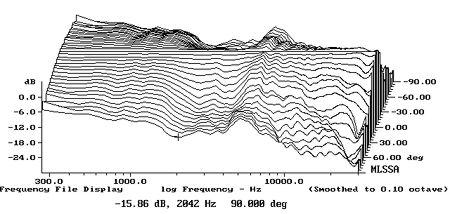
Fig.5 B&W 802D, lateral response family at 50", normalized to response on tweeter axis, from back to front: differences in response 90–5° off axis, reference response, differences in response 5–90° off axis.

Fig.6 B&W 802D, vertical response family at 50", normalized to response on tweeter axis, from back to front: differences in response 15–5° above axis, reference response, differences in response 5–15° below axis.
The 802D's step response (fig.7) indicates that all four drive-units are connected in positive acoustic polarity, with the tweeter's output arriving first at the microphone, followed in quick succession by that of the midrange unit and the woofers. Even with its set-back tweeter, the speaker is not time-coincident. However, it is time-coherent, in that the step response of each unit smoothly integrates with that of the next lower in frequency. This correlates with the flat frequency-domain response seen in fig.4. The 802D's cumulative spectral-decay plot (fig.8) is very clean in the treble region, suggesting that the B&W's midrange unit and tweeter are world-class.
No questions have been asked about this item.
Ask the seller a public question
You must log in to ask a question.
Return Policy
Return Window
Item can be returned within 7 days of receipt.
If you pay using Audiogon Express Checkout (credit card through our marketplace) you will have 7 days from the date of delivery to request a refund, regardless of the seller's return window.
General Terms
Items must be returned in their original condition, with all included packing materials and no signs of use. Buyer assumes responsibility for all shipping return costs unless the item was not received as described.
Refunds
Buyer will receive a full refund in the original payment method less any shipping charges.


